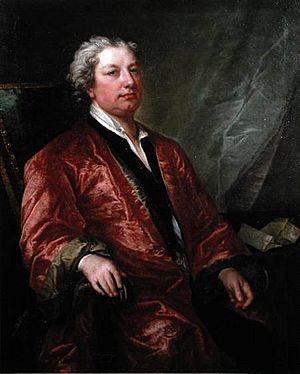Charles Jervas facts for kids
Quick facts for kids
Charles Jervas
|
|
|---|---|
 |
|
| Born | c. 1675 Shinrone, County Offaly
|
| Died | 2 November 1739 London, England
|
| Known for | Portrait painting |
| Spouse(s) | Penelope Hume |
| Patron(s) | George I, George II |
Charles Jervas (also known as Jarvis or Jervis) was an Irish artist. He was a famous portrait painter, a translator, and an art collector. He lived in the early 1700s.
Early Life and Art Training
Charles Jervas was born in Shinrone, County Offaly, Ireland. This was around the year 1675. His parents were John and Elizabeth Jervas.
When he was young, Charles moved to London, England. There, he studied art with a very famous painter named Sir Godfrey Kneller. This was between 1694 and 1695.
Around 1698, Charles made copies of some famous artworks. These were called the Raphael Cartoons. He sold them to a man named Dr. George Clarke. The next year, Charles traveled to Paris and Rome. He stayed there for about ten years. Dr. Clarke and other friends helped him with money during this time. Charles came back to London in 1709. He quickly became a very successful portrait painter.
A Royal Painter

Charles Jervas painted portraits of many important people in London. Some of his close friends were the writer Jonathan Swift and the poet Alexander Pope. You can see their portraits today in the National Portrait Gallery in London.
Because he was so good, many famous writers of the time mentioned Jervas in their books and poems. For example, Alexander Pope wrote a poem called Epistle to Mr Jervas around 1715. This poem was published in 1716.
As his fame grew, Jervas became the main painter for the King. He took over from Sir Godfrey Kneller in 1723. He was the official painter for King George I and later for King George II.
In 1727, Charles Jervas married Penelope Hume. She was a rich widow. After their marriage, they moved to Hampton, London. Charles Jervas lived in London until he passed away in 1739.
Jervas as a Translator
Charles Jervas also worked as a translator. He translated the famous Spanish novel Don Quixote by Cervantes. His translation was published in 1742, after he had died. Because of a mistake by the printer, his name was spelled "Jarvis" on the book. So, it is often called "the Jarvis translation."
Jervas was the first to write an introduction to Don Quixote. In his introduction, he looked closely at other translations of the book. Many people praised his translation for being very accurate. However, some also thought it was a bit serious and lacked humor. Even so, it was printed many times throughout the 1800s.
His Artistic Legacy
Charles Jervas was known for being quite confident in his own abilities. He was also considered lucky. One story says that after he copied a painting by the famous artist Titian, Jervas said, "Poor little Tit, how he would starve!" This showed he thought his own work was better.
Another story tells that Jervas bought a fancy carriage with four horses. When Sir Godfrey Kneller heard about it, he joked, "Oh my goodness, if his horses don't draw better than he does, he will never get to his journey's end!" This was a playful way of saying Jervas's painting skills might not be as good as his new carriage.


